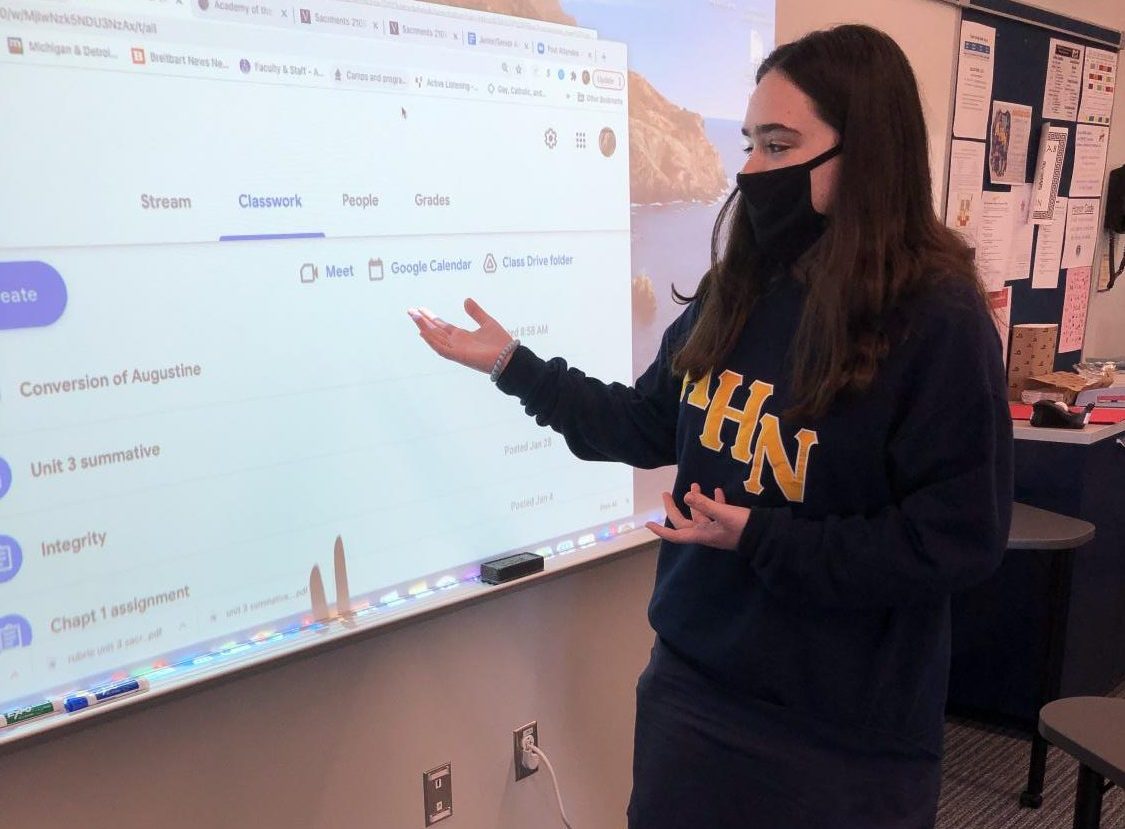In-Class Presentations Should Be Optional (OPINION)
February 10, 2021
In-class presentations are a staple in middle and high schools across the country as a way to showcase the work of students publicly to their classmates. The concept itself is not that difficult, but for many students, class presentations are some of the most nerve-wracking academic endeavors. While it may seem trivial to those who do not struggle to speak in front of people, the fear of standing in front of an audience and presenting is ever-present among some students and can be crippling.
The in-class presentation is often seen in classrooms as an essential part of the curriculum. A teacher’s job is to prepare students for a lifetime of success, and that means there is more to teach than the subject itself. Part of that includes public speaking, which is seen as a necessary skill to prepare students for higher education, job interviews, and professional careers.
“I like doing presentations because even though it takes memorization and practice, it allows us to work on our public speaking skills, which will help us in the long run when we’re applying to jobs and colleges,” said Brynn Wilary (’23).
Normally, the presentations are graded on content and physical appearance of the presentation —as to be expected. However, the issue for many students has to do with another common category for grading: performance. The performance of the presentation is usually the core of the grade, and it involves the presenter’s ability to engage with the audience. Students are graded on their ability to keep eye contact with the audience, to not fiddle with anything while presenting, and to speak without long pauses or the inclusion of filler words like “um” and “like.”
“I think if a teacher is requiring it then it should be forced because it’s a key thing to know how to do when you’re older and it’s an important trait to know how to present things. I don’t think presentations are that of a big deal for me but for other people it may be scary because of their anxiety,” said Colleen Buckhorn (’23).
I had an anxiety attack infront of 35 people and the teachers still say ill get ovet it. No i wont. Im now known as the boy who had an anxiety attack in front of the class
— ryder? (@iinternetclown) September 8, 2018
When it comes to teenagers, in-class presentations are an added source of stress and pressure; this is problematic as the rates for anxiety are increasing among teenagers. The increased pressure on teens to succeed in school is likely a large factor in this, which includes performance of a student’s in-class presentation. Anxiety, as explained by Mayo Clinic, is a collection of disorders when an individual frequently has intense, excessive, and persistent worry about everyday situations. Some students with anxiety are unable to control things like avoiding eye contact, swaying, shaking, and stuttering, and feel that it is unfair and ableist to be graded for something uncontrollable.
Furthermore, presentations can be considered ableist. Ableism is the discrimination of and social prejudice against people with disabilities based on the belief that typical abilities are superior. While no teacher would be intentionally ableist, there are students that believe aspects of in-class presentations are inherently ableist, as they grade students on things that could be caused by a nervous, physical, or mental disorder. There are also physical disadvantages some students have, like those a hard of hearing or blind student may have, making them unable to present as well as someone without any hearing or seeing issues. Another disadvantage would be students that have a speech impediment and are unable to pronounce some words, yet they are graded on the ability to pronounce all words correctly.
On the other hand, there are many students and teachers, with and without anxiety, who think otherwise. These individuals believe that being pushed outside of their comfort zone is necessary and that forcing students to face public speaking fears will help them overcome it. However, it is not that simple; though being required to present may help some students, not every student will be able to “get over it.”
“I think we should do in-class presentations because it improves public speaking and improving public speaking would help you later on in life, like in college and in real life when you’re doing a job,” said Maria Alvarez (’22).
I actually disagree with this 100 percent. I have crippling anxiety and speech skills due to aspergers, but going through speech therapy has helped me so much with that. It never gets easier, but I now know how to manage the anxiety and be more confident talking in that situation
— John Morrow (@SuperJohnny25) September 9, 2018
This begs the question: Have in class presentations become obsolete, and what are some possible solutions to this debate? Some are adamant that students need to present in school to prepare them for the future. There are many alternatives to the traditional in-class presentation though. Some of these options could be presenting privately to the teacher or to a small group of students. Some students believe that they should be able to show knowledge in a different way, such as writing an essay.
The alternatives could help solve the issues that in-class presentations pose. Although it is unlikely they will be removed altogether, more consideration should be given to the weight that in-class presentations are given. As long as in-class presentations are a requirement in classes, it is likely this debate will continue and students will continue struggling.

